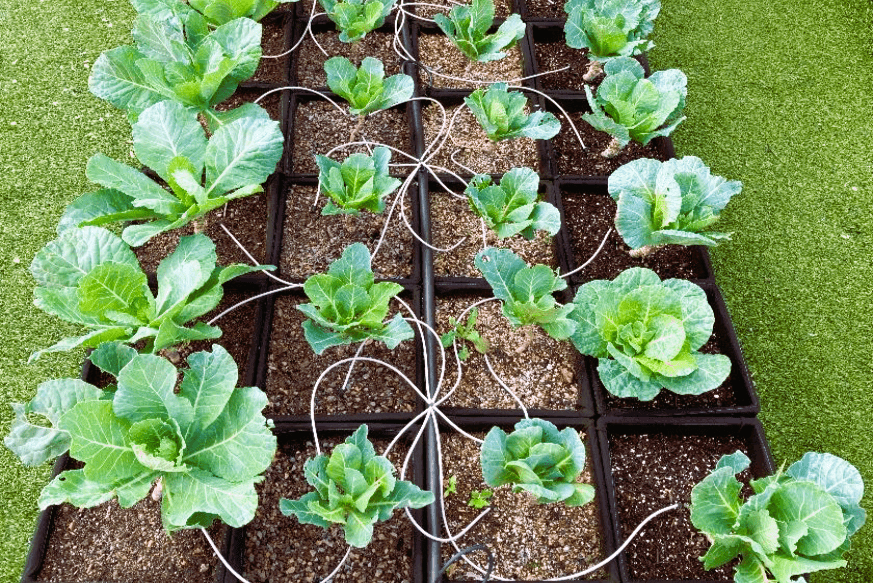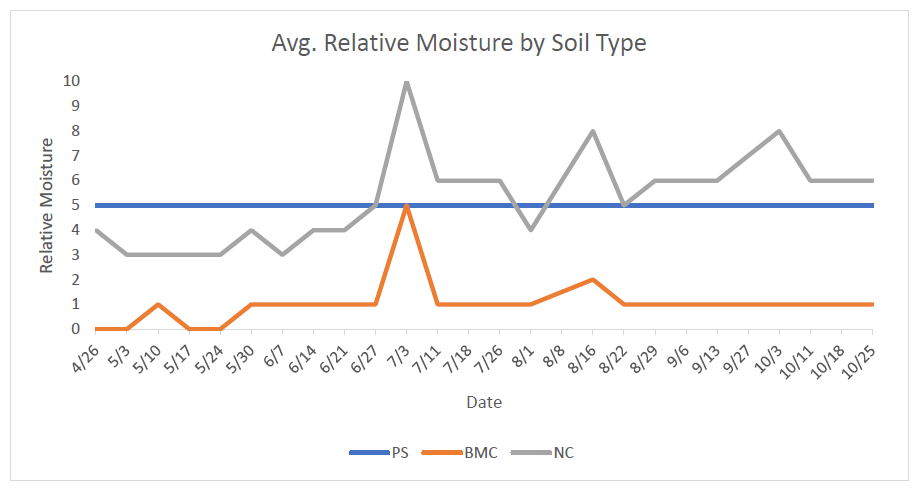Year 1 Study: Urban Agriculture Green Roof Media Efficiency and Crop Cultivation
Advertisement
Urban and rooftop farming has emerged as a sustainable solution to address the growing demand for local and fresh produce in rapidly growing, densely populated areas. A variety of green roof media is commercially available for the development of these urban and rooftop farms and can drastically affect crop cultivation, energy expenditures, water retention, and overall sustainability for urban agricultural practices.
Collard greens growing in various media. Left to Right: Naturcycle, BMC Blend, 3rd Party, Potting Soil. Photo: Lauren Hall, 7/26/23
The Boston Medical Center (BMC) Rooftop Farm is a 2,658 square foot farm with more than thirty varieties of crops. The farm not only provides fresh, local produce to the hospitalized patients, cafeterias, Demonstration Kitchen, and Preventive Food Pantry, but is also part of BMC's commitment to sustainability. The farm reduces storm water runoff, increases green space, and reduces energy use, including the energy required to transport food. The farm was designed and installed by Recover Green Roofs and opened in 2017. Naturcycle LLC is a green roof media manufacturer that operates throughout the Northeast with facilities outside both New York City and Boston. Their team is dedicated to enhancing the environment with local, sustainable materials for landscaping uses, green roof projects, and engineered soil needs.
A collaborative research study is ongoing between the BMC Rooftop Farm and Naturcycle LLC. This project aims to examine the difference in crop cultivation and efficiency across different variations of green roof media. The media included in the study includes 1) a high organic potting soil used as the standard, referred to as “PS,” 2) the urban agriculture blend historically and currently in use at the BMC rooftop garden, referred to as “BMC Blend,” 3) a soilless media blend provided by Naturcycle, referred to as “Naturcycle” or “NC,” and 4) a third-party soilless media which is also in use in some areas of the BMC Rooftop Farm.
Advertisement
Hot peppers harvested from plants grown in various media. Top Left: Potting Soil, Top Right: 3rd Party, Bottom Left: BMC Blend, Bottom Right: Naturcycle.Photo: Lauren Hall, 8/29/23
Data was collected onsite at the BMC Rooftop Farm from April 2023 to October 2023 in the experimental bed areas. Parameters of the research study included information about a variety of soil and crop characteristics. Soil characteristics measured included relative temperature, relative soil moisture, soil composition, and soil compaction. Crop characteristics collected were mostly growth metrics that varied depending on the crop type, which included white daikon radishes, purple daikon radishes, turnips, collard greens, cayenne peppers, habanero peppers, jalapeño peppers, and tomatoes. These growth characteristics included length of largest leaf, width of largest leaf, number of leaves, plant height, and percentage of sprouted plants. The total pounds harvested of each crop by soil type was also computed and weekly harvests were tracked. Qualitative measurements were also taken by documenting growth pictures of the experimental beds to compare real-time growth and pictures taken of harvest to show similarities and differences between harvested crops. While this study shows the differences of crop cultivation across different green roof media, the study also establishes a baseline of Year 1 study parameters. The plan is to continue this study for a Year 2 and Year 3 comparison of the same crops in the same soil type so the efficiency of crop cultivation and soil characteristics can be compared over the years to the baseline data collected in this study as well.
After examining the research parameters, soil characteristics, and growth characteristics, several conclusions and hypotheses can be tested going into a Year 2 study. Potting soil was used as the standard in this study as it is considered the normal growing media for saplings, container plants, and normal gardening to be used in rotation during the growing season across a large variety of plants. However, it is not typical for it to be used in an urban agriculture setting as it is prone to the quick depletion of its nutrient portfolio. The design goal of Naturcycle’s urban agriculture media blend is to be a stable growing media over several growing seasons. While potting soil seems to have a very high crop yield and grew some of the tallest and biggest plants, it also had some of the highest soil compaction, and yield is expected to decrease in Year 2.
Advertisement
Tomatoes harvested from plants grown in various media. Top Left: Potting Soil, Top Right: 3rd Party, Bottom Left: BMC Blend, Bottom Right: Naturcycle. Photo: Lauren Hall, 8/22/23
This version of Naturcycle agriculture media is expected to perform on the same caliber in the Year 2 study as it did in the Year 1 study, even with some slight decrease in crop growth and harvest yield. Based on preliminary Year 1 data, the Naturcycle media is the expected recommendation for long-term (multi-season) agricultural media for dark leafy greens, turnips, radishes, pepper plants, and tomatoes.
One of the more interesting soil characteristics to observe going forward will be the relative moisture measurement. Potting soil was used as the calibration soil and seen as the “ideal” soil moisture measurement. In turn, the other two medias had measurements taken relative to the ideal potting soil container it was calibrated to on a scale of 0-10 (0 being dry, 10 being wet, 5 being ideal conditions). After a consultation with the company that made the relative moisture probe used in the study, we learned that conductivity is used to measure moisture. The electricity travels from the tip of the probe to the rest of the stem which reads on the 0-10 scale display. The moisture meter is also sensitive to changing salts content, and higher salinity will be more conductive, which will make the reading higher even at the same moisture content. This probe does not measure the percentage of moisture as that was measured in the soil composites taken monthly and analyzed at the lab. Comparing the measurements on both provides the same general trends, but it is not a consistent reading for relative moisture of the media for these specific green roof blends. It is theorized that green roof media, which is soilless media made with compost, sand, and aggregates like perlite or expanded shale, may not make sufficient contact with the sheath and tip of the probe to provide an accurate relative moisture reading. Naturcycle is exploring other technologies and plans to test them in Year 2 of the study to examine their effectiveness.
These documented characteristics help provide insight into the most effective practices for green roof media development to help support the ever-growing field of urban agriculture and farming.
Relative Moisture By Soil Type
Advertisement
Lauren Hall, a student at Boston University School of Public Health where she is obtaining her Master’s of Public Health (MPH). She will be graduating in May with a concentration in Epidemiology and Biostatistics and completed the Year 1 research project with BMC and Naturcycle as her public health practicum. She previously obtained a B.S. in Biochemistry from Virginia Tech and will be returning to the project as a Year 2 research coordinator.





